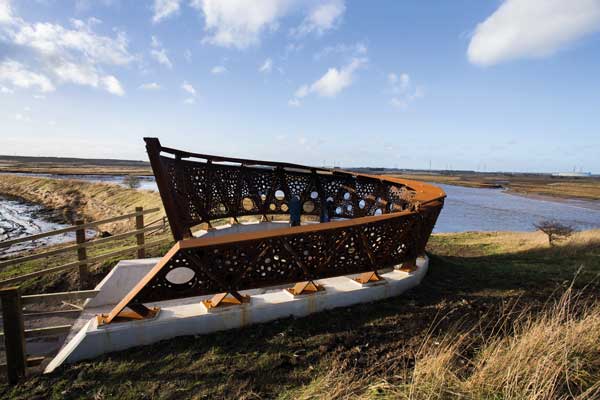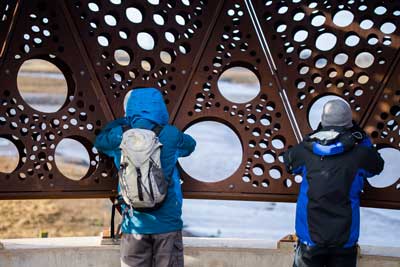SSDA Awards
Merit: Greatham Creek Seal Hide, Middlesbrough
 The use of steel allowed a geometrically complex structure to be built on a constrained site on top of a flood defence embankment.
The use of steel allowed a geometrically complex structure to be built on a constrained site on top of a flood defence embankment.
FACT FILE
Architect: Abstract Machine [Leeds Beckett University]
Structural engineer: BMMJV [Bam Nuttall/Mott MacDonald Joint Venture]
Steelwork contractor: S H Structures Ltd
Main contractor: BMMJV [Bam Nuttall/Mott MacDonald Joint Venture]
Client: Environment Agency
Located in an area of Teesside renowned for its wildlife and a popular destination for birdwatchers and people wishing to photograph seals, an observation hide has been constructed during the building of new flood embankments.
Overlooking the sea at Greatham Creek, the steel-framed hide replaces an old timber structure and has been described as a legacy structure to be enjoyed by those visiting the area for years to come.
Explaining the choice of steelwork for the new hide, Mott MacDonald Technical Principal Adrian Douglas says: “The structure sits at the top of the flood defences, with no access for cranes adjacent to the site. A relatively long radius lift was required for erection which limited the weight of the individual parts of the final structure.
“To satisfy the need for lightweight material and to achieve the durability required by the brief the only options were steel or in-situ concrete. The latter is said to be inappropriate for the functional requirements of a bird hide and expensive to be made architecturally interesting. The use of corrosion resistant weathering steel both resolved the need for repainting the structure and naturally provided a suitable colour.
 “Using steel also enabled an interesting architectural form to be executed within the access constraints of the site,” adds Mr Douglas.
“Using steel also enabled an interesting architectural form to be executed within the access constraints of the site,” adds Mr Douglas.
Funding for the scheme was secured through engagement with Royal Society for the Protection of Birds (RSPB) and Teesside Environmental Trust, with a contribution from the Landfill Communities Fund.
Together with an additional donation from local business the budget available for the hides increased significantly from the original £25,000 to over £100,000, allowing the project team to design a more substantial and aesthetically-pleasing hide.
Several universities were approached about getting involved in the design of the hide, with Leeds Beckett University’s School of Architecture eventually being awarded the job.
Several final year students visited the site in December 2017 and started work on individual concept designs which were presented to the wider project team, including representatives from RSPB and Teesside Environmental Trust in February 2018.
The initial designs were very well received and work then progressed on developing a final option. The undergraduates and alumni of the university worked with Mott MacDonald’s specialist structures team and appointed steelwork supplier S H Structures to progress the design to a final, fully designed and costed solution.
The judges say an enlightened client, and an innovative response from architecture students at Leeds Beckett University, has resulted in a truly unique hide structure. The existing conventional wood hides had to be removed as part of a flood alleviation scheme. Their replacement is formed from sculpted weathering steel and provides a legacy to be enjoyed by visitors to this vibrant wildlife area.
All photos © Vicky Matthews









